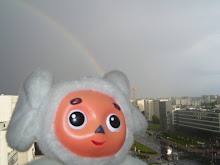There are spots on the fringes of Warsaw (and most other Polish cities) that harbor vast tracts of land devoted to recreational relaxation. Dzialki and gardens make up tiny cities within the city. They turn urban areas into countryside within the space of a few blocks. Almost every family has a dzialka (sometimes two.) They are visited in the summer for R&R, but also to grow veggies for the Polish passions of canning, pickling, and eating fresh.
A reservoir on a tin roof.
Grape vines cover a window.
No spare space is wasted on these tiny plots of land; everything is crammed in: fruit trees, raspberry bushes, zucchinis, and—of course—flowers.
Most dzialki have a small cottage on them. They're more like sheds, often not more than one or two rooms. Others are complete with plumbing and lofts or second stories for sleeping and kitchens. It is not unknown for some poorer families to live year round on their dzialki. Some become farcical mimics of American suburbia, complete with unnaturally lush lawns, mini garages, and vinyl siding. Their owners strut out in the boiling sun cutting grass on a plot the size of a large party tent.
In Communist times, it used to be that every worker had the right to a dzialka. The worker could use it, but he could never sell it or pass it off, making the plot more of company (i.e. government) land than a worker's personal plot. These dzialki sometimes were in prime real estate in the midst of a city. Now, ownership has reverted to the workers (most are now retired) and developers are snapping them up to put in new blocks and business parks.
Last year, the floods effectively wiped out all the dzialki on the banks of the Wisla. People came to spruce up the spring garden, only to find an unrecognizable plot of mud and debris.
It's not that dzialki are endangered or going away. There are still plenty of them, it's just that more and more they are being pushed to the skirmishes of the cities or out of the city proper all together. People, searching for larger and more opulent dzialki, are buying expensive camps and cottages far outside the cities or districts. Mazury is a particularly popular place (not just for its lakes and forests.)
One a different note, some wise in the ways of business have learned to use their dzialki for financial gain. No, they are not selling their veggies (you couldn't make much off that), but there are other ways. One particular way is to buy up a field or two, then put sheep on it. See, the EU pays each farmer per head of sheep, so you immediately start making money from the little lambs wandering around on your fields. Then, once a year you can hire someone to shear the sheep, and profit off the wool. The proceeds can go to buying more heads of sheep.



































